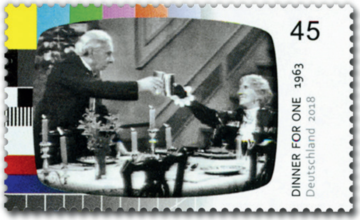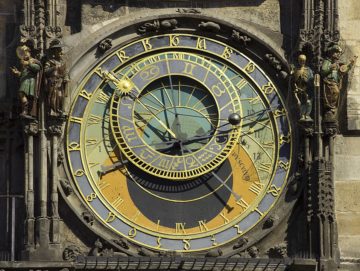by Jochen Szangolies

Time presents itself, depending on the context, under two different modalities: cyclical and linear. Linear time moves always forward, carrying us from past to present, ever towards an uncertain future; while circular time, the time of clock hands, sunrise and sunset, and recurring seasons, sees us back again at our origin.
These would seem to be somewhat in tension. But I find that time, perhaps like all the great mysteries, is only enriched by its seeming contradictions. Take ‘stopping time’, as it is sometimes portrayed in movies—that is, holding everything frozen. How long does such a state last? What is the difference between it lasting an hour, a day, or an eternity? In the absence of change, time is robbed of duration. But in an instant of time, there can be no change. Hence, any instant, it seems, might as well be an infinity, held in the palm of your hand.
We have just come out the tail end of one of the cycles of time punctuating our lives, and emerged into a new one—at least according to the Gregorian calendar. Perhaps it is natural, then, to muse about the way time seems to both sweep us away while, on the arc traced by the Earth around the Sun, always returning us to the same places again—changed, but the same.
Nietzsche was the great augur of time’s cyclical nature. Perhaps the following quotation has shown up on your social media feed in recent weeks:
For the New Year. — I still live, I still think: I still have to live, for I still have to think. Sum, ergo cogito: cogito, ergo sum. Today everybody permits himself the expression of his wish and his dearest thought: hence I, too, shall say what it is that I wish from myself today, and what was the first thought to run across my heart this year—what thought shall be for me the reason, warranty, and sweetness of my life henceforth. I want to learn to see more and more as beautiful what is necessary in things; then I shall be one of those who makes things beautiful. Amor fati: let that be my love henceforth! I do not want to wage war against what is ugly. I do not want to accuse. Looking away shall be my only negation. And all and all and on the whole: someday I wish to be only a Yes-sayer.
For Nietzsche, the concept of amor fati—the love of one’s fate—was tied deeply to the idea that all that is, was, and will be, will be again: the notion of the eternal return of all things. In a time-honored philosophical tradition, Nietzsche, in The Gay Science, lets a demon introduce the concept, having him proclaim:
“This life as you now live it and have lived it, you will have to live once more and innumerable times more; and there will be nothing new in it, but every pain and every joy and every thought and sigh and everything unutterably small or great in your life will have to return to you, all in the same succession and sequence.”
The question, then, is: would you, confronted with this revelation, ‘throw yourself down and gnash your teeth and curse’ the demon—or have you ever experienced a moment where you would instead proclaim him a god and call it the most divine thing you ever heard?
Or, as Nietzsche lets the prophet put it towards the end of Thus Spoke Zarathustra, “if you ever said, ‘You please me, happiness! Abide, moment!’ then you wanted all back. All anew, all eternally, all entangled, ensnared, enamored…” In each moment, recall, there hides an eternity, so to want it once is to want it forever, and to want it with all the rest.
There is, I think, a concept unfamiliar to the present Zeitgeist in these lines: the celebration of what is, the embrace of the wish to have what one has, and nothing more, in perpetuity. Today, we would think of this as stasis, lack of progress, a failure to get out of one’s comfort zone—we are always entreated to want more, to not be satisfied, to seek improvement and perfection. Have a ‘growth mindset’. While there is nothing wrong with trying to better yourself, we are forever locked in unrest and dissatisfaction, driven towards a ‘more’ that is always lessened upon being attained.
In this sense, our society has become Faustian, rebuking Nietzsche’s demon with what Faust proposed to Mephistopheles:
When I say to the Moment flying;
Linger a while—thou art so fair!
Then bind me in thy bonds undying,
And my final ruin I will bear!(Werd ich zum Augenblicke sagen:
Verweile doch! du bist so schön!
Dann magst du mich in Fesseln schlagen,
Dann will ich gern zugrunde gehn!)
Thus, Faust is so certain that he will never be satisfied, never find a moment he considers fit to remain in, to return to, that he stakes his very soul on it. Of course, Faust ends up having a devil of a time with his bargain; so maybe, there is grounds for a critical look at our rejection of the same-old, same-old (but ever re-affirming) in favor of the always-new (but ultimately self-denying).
The Same Procedure As Every Year
Time’s cycles are often marked by ritual, and none more so than the turning of the great celestial clock. One of the most cherished rituals in Germany is to usher in the new year by watching the 1963 comedy sketch Dinner for One, recorded in black and white by the NDR (you can watch it here, if you’re not familiar).
The plot is simple enough: Miss Sophie intends to celebrate her 90th birthday, and has invited her four closest friends. Unfortunately, they have all since passed; nevertheless, she is unwilling to forgo the ritual, and thus, her butler James stands in for each. As this includes a toast with an alcoholic beverage at each course of the evening’s meal, contributing to a progressive inebriation, hijinks, as they are wont to, ensue.

I can’t quite say how the tradition came about, but it’s taken seriously—up to half of all households catch at least one of the various showings on New Year’s Eve, and it is the most often repeated programme on German television. In 2018, Deutsche Post even issued a commemorative stamp. My father’s laughter, always renewed at the always same cues, is a fond childhood memory.
The sketch is, in my unqualified opinion at least, a hilarious masterclass in comedic timing, but I doubt that alone is reason for its popularity. And it must strike one as quite strange: comedy, resting to some degree on surprise, seems to be the genre least well-suited to repeated viewing. But I think there is a lesson here, about what one might call the willing suspension of inurement: to let the new return, as new, again and again. To suspend the modern, cynical seen-it-all attitude in favor of a renewed, wilfull naiveté that renounces all pretense of aloof sophistication in favor of laughing, again, again, and then again at James’ struggle with the tiger’s head.
To see this, we must unpack another of time’s paradoxes: how both its linear and its cyclical modality dwell each within the other. Consider what it might mean to live one’s life again: that one has lived once, followed by another iteration. But what is there to distinguish one from the other? Faced with some number of such cycles, how could we tell which one might have been the first, the second, the thousandth? Which one is lived, and then, which is the one to be lived again? To do so, these cycles must themselves, like beads on a string, be arrayed in linear form: first one, then the other, then the next. Time’s circularity presupposes time’s linearity.

But then, how do we know time’s linear aspect? We saw that without change, there is no duration; hence, change is necessary to mark time. But not any change will do: rather, to mark time, we depend on sequences, revolutions (of clock hands or planets, or indeed societies)—in short, it is periodic, cyclic systems that allow us to delineate what is meant by a second, a minute, a day. To give linear time a measure, we need to find its rhythm. In that sense, time’s linearity presupposes time’s circularity.
Dinner for One reflects this at several levels. James, the butler, walks the same circle around the table again and again; Miss Sophie toasts her (impersonated) friends in always the same sequence; but most obviously, the same exchange repeats between the protagonists: in preparing to serve each course, James asks, “the same procedure as last year?”, which is met with a stern, “the same procedure as every year, James,” with a poignant stress on ‘every’. Clearly, we are to understand that things will be as they were, ever to return to their point of origin.
But we are also shown that circular time is always less than exact, leaving us at a point that is almost, but not quite exactly the same. The sun rises every day, but every day at a slightly different time; wintertime these days is warmer than it used to be. At some point, James manages to avoid the treacherous tiger’s head; coming ever more under the influence, each repeat performance of the toasting ritual is a less than faithful recreation of its predecessor. But most obviously, where once sat Miss Sophie’s friends, there are now only empty chairs: time marches on, even as it ever returns.
New Year, Old Me Anew
The passage of time is always accompanied by loss: or, as the physicist in me would put it, entropy always increases. Time’s teeth eventually gnaw down all we build—“for all that comes to be, deserves to perish wretchedly”, as Mephistopheles puts it. In the face of this, we might well appeal to time’s cyclical nature as salvation—or try to take matters into our own hands, as in Martin Suter’s novel Die Zeit, Die Zeit (‘the time, the time’), where a man tries to bring back his dead wife by rearranging his house and the surroundings so as to perfectly recreate a time when she was still alive—reasoning that time doesn’t exist, only change does.

Strangely enough, there is some support for such a notion in physics: the phenomenon of Poincaré recurrence means that a dynamical system, typically after a very long time, will return to a state arbitrarily close to its initial state (provided the system is bounded in a certain sense, and nothing ‘flies off to infinity’). Taking things a step further, physicist Julian Barbour has indeed argued that there is no such thing as time, there are only moments—little slivers of eternity—which differ from each other in small details, and are ordered only in retrospect, by ‘later’ ones carrying traces—memories or records—of their predecessors, like a picture of a picture.
But this misses something about the ethical dimension of time, which expresses itself differently in both the linear and circular modes. In linear time, our actions echo forth, never to be recalled, no matter the depth of our regret; in circular time, to live a good life, with Nietzsche, is to live a life you could face up to living again (and again). Each demands a care for the future that is absent from the burn-your-bridges rat-race to the top that demands constant self-reinvention and Faustian dissatisfaction, and that is equally negated by the attempt to undo time’s progression.
This care for the future is really the future’s care for us, as Rilke realized: “The future enters into us, in order to transform itself in us, long before it happens.” We are the future, manifested in the present, in order to bring itself about. Care for the future is care for ourselves, and we must account for it in terms of the paradox of both its eternal return and eventual loss.
Thus, on the cusp of this new year, perhaps we should not put so much emphasis on the overcoming of the past, but instead, on becoming the future, and then becoming it again and again: while this year will, undoubtedly, bring new trials, opportunities, happiness and grief in its own mix, try to live it with amor fati in the small. Even though this year, like every year, is unique and irretrievable, we should wish for it to be such that that, at its end, if we are asked, “the same procedure as last year?”—we can answer: “the same procedure as every year.”
